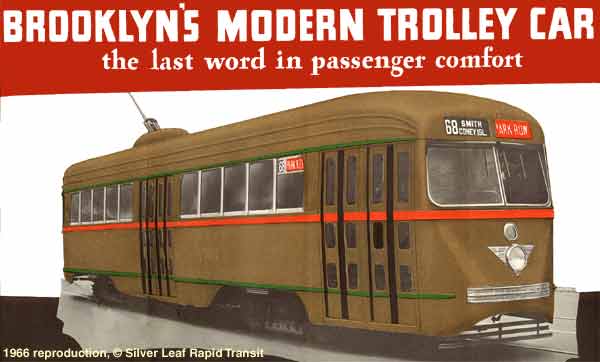Back to the Future—
New York's Lost Transit Legacy
Page 4
The Great Depression
In 1929, the Great
Depression set in. This largest of American business panics was a great
blow to the electric railway industry in New York and nationally and one
of the key factors in the industry’s decline.
The Depression gave a boost to the City’s desire to own and operate not
only its under-construction Independent system, but the BMT and IRT as
well.
The economic downturn was the last straw
for the IRT: the decline in ridership was added to the financial strains
of its onerous lease of the Manhattan Elevated lines and the City’s
refusal to allow it to raise the five-cent fare. Bankruptcy was the IRT’s
lot, and selling out to the City began to look more like salvation than
defeat.
Innovation in Hard
Times
The BMT refused to go down for the
count, however. Management felt it could overcome both hard times and City
competition with innovation. As it had in the past, it went direct to the
public to show it the future at a time when most were grateful to live
day-to-day.
In December 1932, discussions
began as to the construction of an aluminum rapid transit car. In June
1933, the Transit Commission gave its approval for the BMT to construct
such a car. A few months later, it approved a stainless steel car as
well.
On June 19th and 20th, 1934, the
aluminum car, unofficially styled The Green Hornet, made its public debut at the
Park Row terminal of the BMT elevated lines. Built by the Pullman Car and
Manufacturing Corporation, it featured a futuristic curved body design
which earned it the nickname “Blimp,” but this was in jest, as this
two-toned green beauty heralded a new era for transit
riders.
Later in 1934 the pioneer of stainless
steel railway construction, the J.G. Budd Company, delivered its own
version of the elevated car of the future, popularly called the “Zephyr”
after the ultra-modern diesel units Budd was building for the Burlington
railroad lines.
Both cars were dubbed “Multi-Section Cars” by the
BMT. The cars appeared to solve all the BMT’s future elevated car needs at
once. The Hornet, Zephyr and the 1935 production order of
25 multi-section cars each consisted of five sections combined into a single
unit and carried on six trucks. This was done using the principle of articulation, of which the BMT was a leading
advocate.
Articulated cars had a truck
assembly (the mechanism holding the running wheels) at the extreme ends of
each five-section unit, plus a single truck underneath the joints between
any two sections.
The term “articulated” is used in nature to describe snakes,
whose segmented bodies allow them to slither through tight spots that would
trap larger, bulkier, beasts. The snake analogy aptly describes one of the
great advantages of the Multi-Section Cars—they snaked around the tight curves
of the older parts of Brooklyn’s elevated system. Paradoxically, they created a
longer car for the passenger. The Hornet was 170 feet overall, as long as
the body sections of four elevated cars, yet riders could stroll among the five
individual sections through passageways called vestibules,
without subjecting themselves to the discomforts of weather or the danger
of passing between swaying cars.
The Multi-Section cars were also
fast. Lighter weight and more powerful motors made riding them a
hold-your-hat experience, even if you weren’t wearing one. The BMT estimated
that a fleet of Hornets would
trim the running time of a Fulton Street Local, encompassing 11.3 miles
and 32 station stops, from 49 to 36 minutes.
But what about weight? Could the BMT “lower the river” with cars capable
of operating on existing structures instead of “raising the bridge” with
the massive capital expenditures of completely rebuilding els or new
subway lines?
Although elevated cars were lighter in terms of axle loading
than subway cars, the weight per passenger carried, which determines how much
energy is used to carry each passenger, is comparable. The BMT’s heaviest car,
the subway Triplex, weighed 212 pounds per square foot of floor area fully
loaded. A BRT el car worked out to a surprisingly close 204 pounds. The Green Hornet
slashed this weight to 158 pounds.
It is axle loading, however—the weight carried by each car
axle—that determines whether a car could operate on one of the old structures
at all. A loaded Triplex maxed out at 40,000 pounds per axle. A wooden elevated
car put 28,000 pounds on each axle, while the Hornet blew both away at
only 23,600 pounds.
In the early Fall of 1936,
after extensive revenue testing on the Canarsie Line, the BMT and its
passengers saw the first (and last) fruits of its light-weight technology
efforts. Multi-section cars, based on the Hornet design, began service
from the 14th Street subway in Manhattan to the outer reaches of the
Fulton Street elevated line.
Continued on page 5

The BMT was also in
the forefront of advanced streetcar design, as announced by this 1936
brochure. Cars like this one spread across the U.S. and Canada and similar
designs were deployed worldwide. New York's Mayor LaGuardia forced the BMT
to cancel its order for an additional order of 500 of these cars.
Technology prioneered in this design was used in the
Bluebird. Paul Matus Collection
The Third Rail and The Third Rail
logo are trademarks of The Composing Stack Inc.
|

